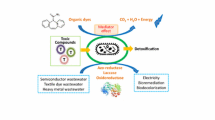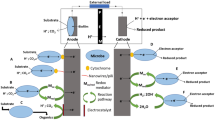Abstract
Objectives
To investigate the contribution of direct electron transfer mechanisms to electricity production in microbial fuel cells by physically retaining Shewanella oneidensis cells close to or away from the anode electrode.
Results
A maximum power output of 114 ± 6 mWm−2 was obtained when cells were retained close to the anode using a dialysis membrane. This was 3.5 times more than when the cells were separated away from the anode. Without the membrane the maximum power output was 129 ± 6 mWm−2. The direct mechanisms of electron transfer contributed significantly to overall electron transfer from S. oneidensis to electrodes, a result that was corroborated by another experiment where S. oneidensis cells were entrapped in alginate gels.
Conclusion
S. oneidensis transfers electrons primarily by direct electron transfer as opposed to mediated electron transfer.







Similar content being viewed by others
References
Bickerstaff GF (2009) Immobilisation of enzymes and cells. In: Walker JM, Rapley R (eds) Molecular biology and biotechnology. RSC Publishing, Cambridge
Fernando E, Keshavarz T, Kyazze G (2012) Enhanced bio-decolourisation of acid orange 7 by Shewanella oneidensis through cometabolism in a microbial fuel cell. Int Biodeter Biodegrad 72:1–9
Finch AS, Mackie TD, Sund CJ, Summer JJ (2011) Metabolite analysis of Clostridium acetobutylicum fermentation in a microbial fuel cell. Bioresour Technol 102:312–315
Gralnick JA, Newman DK (2007) Extracellular respiration. Mol Microbiol 65:1–11
Harnisch F, Aulenta F, Schroder U (2011) Microbial fuel cells and bioelectrochemical systems: industrial and environmental biotechnologies based on extracellular electron transfer. In: Moo-Young M (ed) Comprehensive biotechnology, 2nd edn. Elsevier, Amsterdam, pp 643–659
Kotloski NJ, Gralnick JA (2013) Flavin electron shuttles dominate extracellular electron transfer by Shewanella oneidensis. MBio 4:e00553
Kracke F, Vassilev I, Kromer JO (2015) Microbial electron transport and energy conservation—the foundation for optimising bioelectrochemical systems. Front Microbiol. doi:10.3389/fmicb.2015.00575 (Article 575)
Lee SW, Jeon BW, Park DH (2010) Effect of bacterial cell size on electricity generation in a single-compartimented microbial fuel cell. Biotechnol Lett 32:483–487
Logan BE (2008) Microbial fuel cells. Wiley-Interscience, Hoboken
Mohan SV, Rhagavulu SV, Sarma P (2008) Influence of anodic biofilm growth on bioelectricity production in single chambered mediatorless microbial fuel cell using mixed anaerobic consortia. Biosens Bioelectr 24:41–47
Okamoto A, Hashimoto K, Nakamura R (2012) Long-range electron conduction of Shewanella biofilms mediated by outer membrane c-type cytochromes. Bioelectrochemistry 85:61–65
Oliveira VB, Simoes M, Melo LF, Pinto AMFR (2013) Overview on the developments of microbial fuel cells. Biochem Eng J 73:53–64
Westwood D (2007) The determination of chemical oxygen demand in waters and effluents. Environment Agency, National Laboratory Service
Wrighton K et al (2011) Evidence of direct electron transfer by a gram positive bacterium isolated from a microbial fuel cell. Appl Environ Microbiol 77:7633–7639
Zhao F, Slade RC (2009) Techniques for the study and development of microbial fuel cells: an electrochemical perspective. Chem Soc Rev 38:1926–1939
Zhuang L, Chen Q, Zhou S, Yuan Y, Yuan H (2012) Methanogenesis control using 2-bromoethanesulfonate for enhanced power recovery from sewage sludge in air-cathode microbial fuel cells. Int J Electrochem Sci 7:6512–6523
Acknowledgments
Segun Fapetu wishes to thank his family for sponsoring his PhD studies.
Author information
Authors and Affiliations
Corresponding author
Rights and permissions
About this article
Cite this article
Fapetu, S., Keshavarz, T., Clements, M. et al. Contribution of direct electron transfer mechanisms to overall electron transfer in microbial fuel cells utilising Shewanella oneidensis as biocatalyst. Biotechnol Lett 38, 1465–1473 (2016). https://doi.org/10.1007/s10529-016-2128-x
Received:
Accepted:
Published:
Issue Date:
DOI: https://doi.org/10.1007/s10529-016-2128-x




